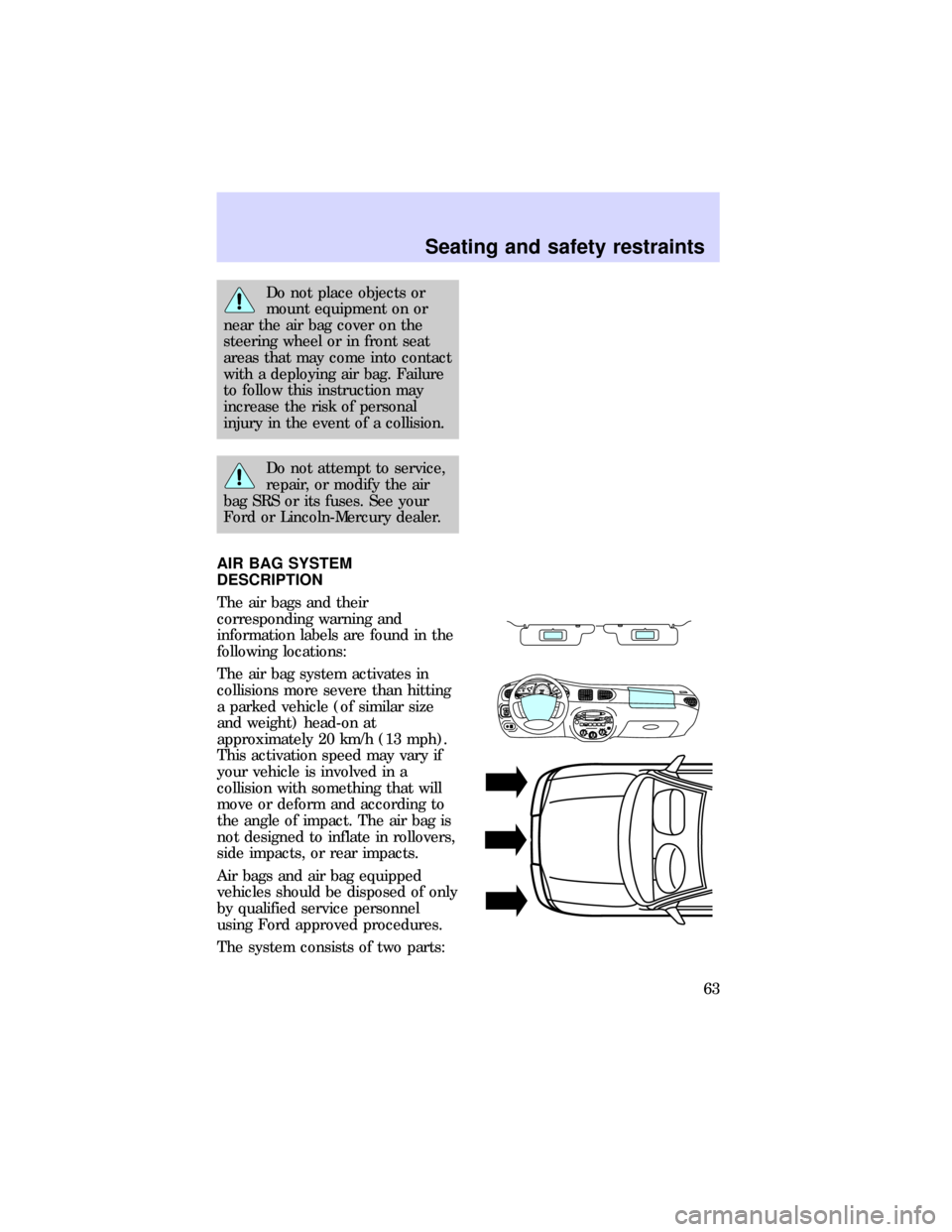Page 2 of 191
ICONS
The following icons appear in this
Owner Guide:
indicates a warning. Read the
following section onWarningsfor
a full explanation of warnings.
indicates that vehicle
information related to recycling
and other environmental concerns
will follow.
Warnings
Warnings remind you to be
especially careful in those areas
where carelessness can cause
damage to your vehicle or personal
injury to yourself, your passengers,
or others. Please read all warnings
carefully.
Breaking-in your vehicle
Your new vehicle goes through an
adjustment or breaking-in period
during the first 1,600 km (1,000
miles) of driving. During this
period:
²change your vehicle's speed
often as you drive. Do not drive
at one speed for a long time.
²use only the type of engine oil
Ford recommends. Do not use
special ªbreak-inº oils.
²avoid sudden stops. The
break-in period for brake linings
lasts for 1,600 km (1,000 miles)
of highway driving or 160 km
(100 miles) of city driving.
Introduction
2
Page 57 of 191
Vehicle sensitive (emergency)
locking mode
The vehicle sensitive mode is the
normal retractor mode, which
locks the belts in response to
vehicle movement. For example, if
the driver brakes suddenly or turns
a corner sharply, the combination
safety belts will lock to restrain
forward movement of the driver
and passengers.
The retractor can be made to lock
by pulling sharply on the belt.
Automatic locking mode
In this mode, the occupant is
locked in a certain position by the
shoulder belt and the belt does not
adjust tightness during vehicle
movement.
The automatic locking mode is not
available on the driver safety belt.
When to use the automatic
locking mode
²When a tight lap and shoulder
belt fit is desired.
²Any timea child safety seat is
installed in the vehicle. For
more information on the proper
use of a child safety seat, refer
toChildren and infant or
child safety seatslater in this
chapter.
Seating and safety restraints
57
Page 63 of 191

Do not place objects or
mount equipment on or
near the air bag cover on the
steering wheel or in front seat
areas that may come into contact
with a deploying air bag. Failure
to follow this instruction may
increase the risk of personal
injury in the event of a collision.
Do not attempt to service,
repair, or modify the air
bag SRS or its fuses. See your
Ford or Lincoln-Mercury dealer.
AIR BAG SYSTEM
DESCRIPTION
The air bags and their
corresponding warning and
information labels are found in the
following locations:
The air bag system activates in
collisions more severe than hitting
a parked vehicle (of similar size
and weight) head-on at
approximately 20 km/h (13 mph).
This activation speed may vary if
your vehicle is involved in a
collision with something that will
move or deform and according to
the angle of impact. The air bag is
not designed to inflate in rollovers,
side impacts, or rear impacts.
Air bags and air bag equipped
vehicles should be disposed of only
by qualified service personnel
using Ford approved procedures.
The system consists of two parts:
HI LOOFF*A/C*MAX
A/CTUNE
DISCS
SEEK
TUNE
SCAN
EJ REW FF
BAL BASSTREBFADE TAPE
CD AM
FM
–+1
SIDE 1-22
345
COMP1
SIDE 1-2VOL–
PUSH ONLMIRRORR00000000002030405060
70
80
90
10 0
11 020 40608010 0
12 0
16 0
18 0 140
200FUEL FILLCHEF1/22
13RPM x 1000RSM
SET
ACC
CST OFF ONOFFINT
1 OFF MIST
Seating and safety restraints
63
Page 90 of 191

2. Press the accelerator all the way
to the floor and hold.
3. Turn the key to START. Release
it once the engine starts.
4. Release the accelerator
gradually as the engine speeds up.
If the engine still does not start,
refer toFuel pump shut-off
switchin theRoadside
emergencieschapter.
Using the engine block heater
(if equipped)
Engine block heaters are strongly
recommended if you live in a
region where temperatures
consistently reach -29ÉC (-20ÉF) or
below during the winter months.
An engine block heater warms the
engine coolant, which improves
starting, warms up the engine
faster, and allows the
heater-defrost system to respond
quickly.
If your vehicle is equipped with an
engine block heater, use it
whenever the temperature is -23ÉC
(-10ÉF) or below.
To turn the heater on, plug it into
a grounded 110-volt outlet. It is
recommended that you use a
110-volt circuit that is protected
by a Ground Fault Circuit
Interrupter.
For best results, plug the heater in
at least three hours before you
start your vehicle. Using the heater
for longer than three hours will not
damage the engine, so you can
Starting
90
Page 94 of 191
The ABS brake system conducts a
self-test each time the vehicle is
driven. A mechanical noise may be
heard while the system conducts
its self-test.
ABS warning light
TheABSlight in the instrument
cluster illuminates and remains
illuminated if an ABS fault is
detected. Have your vehicle
serviced by a qualified service
technician as soon as possible.
Normal braking operation is still
effective unless the
P!BRAKElight is
also illuminated.
Parking brake
The parking brake should be used
whenever the vehicle is parked.
To set the parking brake:
The parking brake is not designed
to stop a moving vehicle. However,
if the normal brakes fail, the
parking brake can be set to stop
the vehicle. The vehicle's stopping
distance will increase greatly and
vehicle steering response will be
limited.
When the ignition is turned to ON,
the
P!BRAKElight in the instrument
cluster illuminates and remains
illuminated until the parking brake
is released.
Driving
94
Page 138 of 191

produce coolant which meets Ford
specification ESE-M97B44-A, and
use of such coolant may harm
engine and cooling system
components.
Always dispose of used automotive
fluids in a responsible manner.
Follow your community's
regulations and standards for
recycling and disposing of
automotive fluids.
Coolant Refill Capacity
To find out how much fluid your
vehicle's cooling system can hold,
seeRefill capacities for fluidsin
the Index.
Have your dealer check the engine
cooling system for leaks if you
have to add more than a quart
(liter) of engine coolant per
month.
Severe Winter Climate
If you drive in extremely cold
climates (less than -34ÉF [-36ÉC]),
it may be necessary to increase the
coolant concentration above 50%.
Refer to the chart on the coolant
container to ensure the coolant
concentration in your vehicle is
such that the coolant will not
freeze at the temperature level in
which you drive during winter
months. Never increase the engine
coolant concentration above 60%.
Leave a 50/50 mixture of engine
coolant and water in your vehicle
year-round in non-extreme
climates.
Maintenance and care
138
Page 142 of 191
²Add the fluid in 250 ml (1¤2pint)
increments through the filler
tube. Do not overfill the
automatic transaxle fluid
reservoir. If this occurs, the
excess fluid should be removed
by a qualified technician.
Always dispose of used
automotive fluids in a responsible
manner. Follow your community's
standards for disposing of these
types of fluids. Call your local
recycling center to find out more
about recycling automotive fluids.
Checking and adding manual
transaxle fluid
For information on checking and
adding manual transaxle fluid,
refer toChecking and adding
clutch fluidin this section.
WHAT YOU SHOULD KNOW
ABOUT YOUR BATTERY
If the original equipment
maintenance-free battery needs
replacing, it may be replaced with
a low-maintenance battery. For
information on appropriate
replacement batteries, refer to
Motorcraft part numbersin the
Capacities and specifications
chapter.
Maintenance and care
142
Page 145 of 191
of your vehicle may be adversely
affected until the idle is
eventually relearned.
²If the battery has been
disconnected or a new battery
has been installed, the clock and
preset radio stations must be
reset once the battery is
reconnected.
²Always dispose of used
automotive batteries in a
responsible manner. Follow your
community's standards for
disposal. Call your local
recycling center to find out
more about recycling automotive
batteries.
CHECKING AND CHANGING
YOUR AIR FILTER
If the vehicle is operated in very
dusty or sandy areas, replace the
filter more often than the
recommended intervals.
Do not drive without an air
filter; this could result in
excessive engine wear.
Maintenance and care
145